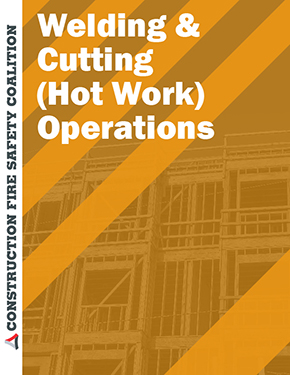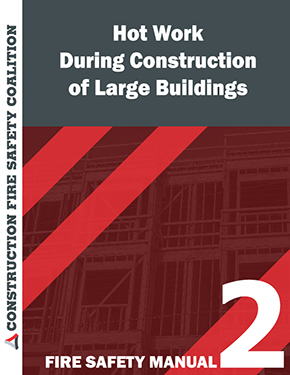Home / Best Practices / Conducting Hot Work Safely
Conducting Hot Work Safely
The purpose of this section is to provide some guidance on how to comply with Chapter 26 of the IBC and Chapter 41 of the 2015 Edition of NFPA 1.
Cutting, soldering, brazing and welding operations are commonly referred to as hot work. Potential health, safety, and property hazards result from the fumes, gases, sparks, hot metal and radiant energy produced during hot work. Hot work equipment, which may produce high voltages or utilize compressed gases, also requires special awareness and training on the part of the worker to be used safely. The hazards associated with hot work can be reduced through the implementation of effective control programs.
The following are definitions that may be used in describing best management practices in conducting “HotWork”.
Hot Work Area
The area exposed to sparks, hot slag, radiant heat, or convective heat as a result of the Hot Work.
Hot Work Equipment
Electric or gas welding or cutting equipment used for Hot Work
Hot Work Permits
Permits issued by an approved responsible person under the Hot Work Permit program permitting welding or other Hot Work to be done in temporary and fixed locations referred to in Sections 2603 and 2604.
Hot Work Program
A permitted program, carried out by approved facilities-personnel allowing them to oversee and issue permits for Hot Work conducted by their personnel or at their facility. The intent is to have trained; on-site, responsible personnel ensure that required Hot Work safety measures are taken to prevent fires and fire spread.
Responsible Party
A person trained in the safety and fire safety considerations concerned with Hot Work. Responsible for reviewing the sites prior to issuing permits as part of the Hot Work permit program and following up as the job progresses.
Torch-Applied Roof System
Bituminous roofing systems using membranes that are adhered by heating with a torch and melting asphalt back coating instead of moping hot asphalt for adhesion.
Because of the requirements of the codes.
The Occupational Safety and Health Administration (OSHA) and local Building and Fire Codes prohibit cutting and welding operations unless appropriate steps are taken to minimize fire hazards, such as removal or guarding of combustible materials and, when possible, restricting hot work to specially designated areas. The responsible party where hot work is performed is responsible for ensuring that adequate controls and procedures are in place before work begins.
Hot Work permits shall be obtained from the appropriate authority before the commencement of any operation involving metal burning, cutting, welding, brazing and/or any other procedure that produces sparks and heat. Any contractor scheduled to perform this work who has questions regarding Hot Work, or whether a permit shall be issued should contact the authority having jurisdiction.
The applicable procedure on the permit, in addition to any additional governmental regulations currently in effect, shall follow to the letter.
- Clear the area of all combustible materials.
- Have an adequate fire extinguisher standing by. My adequate we are referring to the proper type and size of extinguisher for the situation.
- Use fire retardant blankets when appropriate.
- Inspect the area after the hot work is been completed for any potential ignition.
- Re-inspect the area after a period of at least one hour has expired after the hot work is been completed.
- Upon completion of the hot work final inspection, the responsible party should return a signed hot work permit to the project manager or construction inspector whoever is responsible for accountability for the hot work process.
Because heat combined with a fuel, especially a “fine fuel” like paper or cardboard or sawdust can result in an ignition of a fire. Once ignition occurs fire can spread extremely rapidly in the construction phase environment. This is because there are many fuel sources that can ignite thereby contributing to an even more rapid fire spread.
Construction sites can present many hazards to employees. When performing construction-related activities it is very common to create trash and debris. Keeping a construction site relatively clean of debris can further reduce hazards. The benefits of good housekeeping far exceed the small additional effort required to establish good housekeeping practices at a construction site.
Employees on construction sites should practice good housekeeping to further reduce hazards on these sites. This means controlling and removing the amount of debris, waste and form lumber, as well as hazardous wastes in the area. Removing these materials at regular intervals during the course of construction should be accomplished without increasing the hazard exposure to employees who remove such debris. Nails should be removed from used lumber before stacking. Noncombustible scrap material and debris that consist of form and scrap lumber with protruding nails, and all other debris, must also be kept cleared from work areas, passageways, and stairs, and from around buildings or other structures. These are a safety hazard to both construction crews and firefighters that might have to work in the area.
When construction hazards exist that cannot be eliminated, then engineering practices, administrative controls, safe work practices, Personal Protective Equipment (PPE), and/or proper training must be implemented.
All construction waste must first be collected into containers before disposal. These wastes include General Waste and Trash (nontoxic, non-hazardous) and Hazardous Wastes. Separate containers must be provided for the collection and separation of waste, trash and other refuse.
Additional separate containers must be provided with lids for hazardous wastes to prevent sparks or other ignition sources from coming into contact with hazardous wastes. Hazardous Wastes can include used oil, used oil filters, oily rags and flammable wastes as well as caustics, acids, harmful dusts, etc.
Debris: Unusable or unwanted construction waste material.
Form Lumber: Lumber that is used to contain liquid concrete into defined shaped until the concrete hardens.
Hazardous Wastes: Waste that is either toxic to humans or to the environment.
Hazards associated with compressed gases include oxygen displacement, fires, explosions, and toxic gas exposures, as well as the physical hazards associated with high pressure systems. Special storage, use, and handling precautions are necessary in order to control these hazards. Compressed gas and equipment is addressed in specific standards for the general industry, shipyard employment, marine terminals, and the construction industry.
See the following websites:
https://www.osha.gov/SLTC/compressedgasequipment/
https://www.safetyinfo.com/guest-library/materials/written-safety-programs/compressed-gas-cylinder-safety-program
http://www.wsmr.army.mil/PDF/compressedgassafety.PDF
Personal protective equipment specifically designed for hot work should be provided to and used by personnel conducting operations. The potential for toxic fume emissions from the material being worked on or surface coatings should be considered and appropriate steps should be taken to provide for respiratory protection if appropriate.
See the following website:
Remember that sparks, slag and splatter can travel in all directions from where you are operating. They can travel up to 35 feet from the work, sometimes to locations that are out of you sight. If you have removed all combustible material that is loose or cast about, and you have prevented flammable gases of liquids from accumulating in your work area you have accomplished a great deal. However, the task is not complete unless you have proper fire extinguishment equipment available. Fire and explosions are not “accidents. ” They occur when a person working with materials loses sight of the potential and becomes apathetic to the possibility of a fire. Being aware of your surroundings is an import part of preventing fires.
Delay of alarm when a fire occurs can have catastrophic results. The reason is very simple. When a fire occurs it is likely because some heat source came into contact with a fuel and the fire starts small. Every second from that point on can result in more and more damage. Every minute becomes more important than the previous. This is not a section on fire science, but one fact should be considered by anyone that sees a fire start. Every minute that goes by causes the fire to increase by 4 to 6 times in producing more heat. In less than 5 minutes a fire can grow from a small fire to a very large one. This is very important because the fire department requires a minimum of 5 to 6 minutes of time to process an alarm and respond to the scene. The passage of 15 minutes – or a delay as long as 30 minutes can result in fire magnitude that overwhelms even the most aggressive of firefighting crews. If the fire service is to have any chance of control of a fire they HAVE TO BE NOTIFIED IMMEDIATELY.
Equipment and technology must be readily available for the employees to make a prompt response. Therefore, make sure you have answers to the following questions:
- Who is the designee and the back-up person responsible to sound the alarm?
- Who is the designee and the back- up person responsible to notify the fire agency?
- Have instructions been given to all employees on site as to what to do if the alarm has been sounded on site?
- Has there been a “muster” point (or meeting place) designated for all personnel on site?
- Is there a list of on-site personnel and has it been up-dated?
- Are there personnel assigned to meet with the fire department upon their arrival, so they can give information on the fire and any possible injuries?
Then check out the following:
- Identify the local fire department and verify the following;
- The telephone Contact # –.
- Distance from site – Know how far away the fire department is. This may help you establish additional fire protection methods at the site.
- Verify that the specific location or address is known – In many instances addresses do not show up on GPS and Google maps. You should make sure that the local fire department knows your location before works begins. It is a good idea to invite them to the site before work begins and every 6 months to show them changing conditions.
Once the fire service has been notified the person who discovered the fire should try to use the extinguishing equipment that is provided, but they should NEVER risk their life in doing so. An aggressive attack with one or two properly sized extinguishers can do a lot to slow down a fire. However, an employee that discovers a fire should NEVER delay getting help on the way. Next to preventing the ignition of the fire in the first place, getting help on the way is the number one priority of the workers on a site.
All persons performing hot work should be trained in proper equipment operation, handling and storage of welding materials, compressed gas safety, chemical hazards, and in working procedures, including the written hot work permit. Additional training may also be necessary in the proper selection and use of personal protective equipment.
Training in confined space entry is necessary before working in confined space areas.
See the following websites:
https://www.osha.gov/dte/edcenters/course_description.html
http://www.nfpa.org/codes-and-standards/document-information-pages
A person other than the operator should perform fire watch duties and remain at the work site for at least 30 minutes after hot work operations have ended. Additionally, the following steps should be taken:
- A fire extinguisher rated at not less than 2-A:20-B:C must be available in shop areas where hot work is performed;
- A fire extinguisher rated at not less than 2-A:10-B:C must be attached to all portable cutting and welding carts;
- If a building or area is equipped with a sprinkler system, then that system must be operational when hot work is performed;
For more information on a self-audit of the process see the following websites.
http://www.oshatrain.org/pdf/audit1.pdf
http://www.envirosafetyproducts.com/resources/oshaguidelines.html
http://www.tdi.texas.gov/pubs/videoresource/cklgenindustry.pdf
https://web.princeton.edu/sites/ehs/healthsafetyguide/checklists/HotWork.pdf
- Ensure all procedures are followed
- Hold personnel accountable
- conduct frequent reviews of procedures as part of the training
For additional research see:
http://web.princeton.edu/sites/ehs/healthsafetyguide/B10.htm

